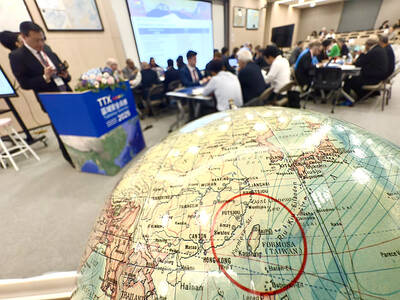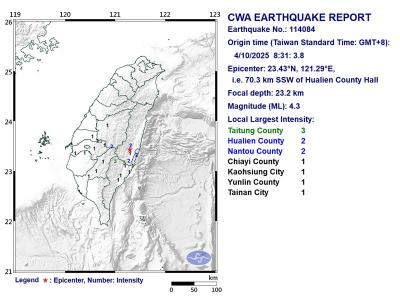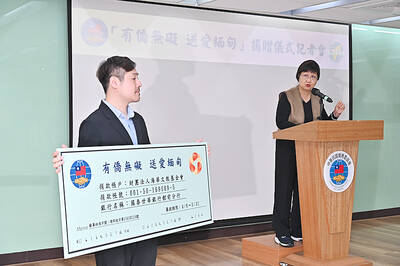To protect the coastline near a wharf built to receive heavy equipment for the Fourth Nuclear Power Plant, the government is considering partly removing two breakwaters near the wharf, Public Construction Commission Vice Chairman Kuo Ching-chiang (郭清江) said yesterday.
Kuo said the change to the wharf's design would not affect the planned starting date of the plant's operations.
The wharf, enclosed by the two breakwaters, is designed to accommodate heavy machinery on its way to the construction site of the nuclear plant in Kungliao Township.
Last month, Taiwan Power Company, the operator of the plant, unloaded a 1,007-tonne nuclear pressure vessel from the wharf, which is key to the company's plan to meet its target of July 2006.
The wharf, however, has been a bone of contention not only with local residents but also environmentalists since 2000 for the impact it has had on nearby Fulung Beach.
In April, a Cabinet task force investigating coastal erosion near the wharf concluded that the loss of sand at the beach could be attributed to stress to the environment caused by construction of the wharf. Late last month, the task force came up with three possible solutions.
According to Kuo, the first idea -- having Taipower supply sand to the beach -- was opposed by local residents, who could no longer tolerate the continuing loss of sand.
Kungliao-based Northeast Coast National Scenic Area Administration Tourism Bureau under the Ministry of Transportation and Communications, which administers Fulong Beach, is also concerned about the deteriorating coastal environment. According to ministry officials, the beach is about 50cm lower than before, attracting fewer tourists.
Kuo said the second idea -- rebuilding the wharf and associated buildings at a cost of NT$15 billion -- might be too expensive for Taipower.
A possible solution, Kuo said, is the combination of the these two ideas -- pulling down half of the two breakwaters and having Taipower supply sand to replace lost sand at the beach.
"This could be a solution because of its low cost and because it is environmentally friendly," Kuo said.
Kuo said that the Cabinet had demanded an evaluation of the third option from Taipower, which will reply in a few weeks. The project would cost about NT$1.2 billion.
Kuo said a change in the design of the wharf would not affect the launch of the plant's operations because it would not be completed until after 2005.
Taipower officials said that changing the design of the wharf was not an easy task. It plans to import the second reactor from Japan before any changes to the wharf are made.
"The second nuclear pressure vessel will be transferred no later than early next year in order to start generating power in 2007," said Lin Yuan-te (林源得), Taipower's deputy manager for the Lungmen Construction Office in Kungliao.

DEFENSE: The National Security Bureau promised to expand communication and intelligence cooperation with global partners and enhance its strategic analytical skills China has not only increased military exercises and “gray zone” tactics against Taiwan this year, but also continues to recruit military personnel for espionage, the National Security Bureau (NSB) said yesterday in a report to the Legislative Yuan. The bureau submitted the report ahead of NSB Director-General Tsai Ming-yen’s (蔡明彥) appearance before the Foreign and National Defense Committee today. Last year, the Chinese People’s Liberation Army (PLA) conducted “Joint Sword-2024A and B” military exercises targeting Taiwan and carried out 40 combat readiness patrols, the bureau said. In addition, Chinese military aircraft entered Taiwan’s airspace 3,070 times last year, up about

Taiwan is stepping up plans to create self-sufficient supply chains for combat drones and increase foreign orders from the US to counter China’s numerical superiority, a defense official said on Saturday. Commenting on condition of anonymity, the official said the nation’s armed forces are in agreement with US Admiral Samuel Paparo’s assessment that Taiwan’s military must be prepared to turn the nation’s waters into a “hellscape” for the Chinese People’s Liberation Army (PLA). Paparo, the commander of the US Indo-Pacific Command, reiterated the concept during a Congressional hearing in Washington on Wednesday. He first coined the term in a security conference last

A magnitude 4.3 earthquake struck eastern Taiwan's Hualien County at 8:31am today, according to the Central Weather Administration (CWA). The epicenter of the temblor was located in Hualien County, about 70.3 kilometers south southwest of Hualien County Hall, at a depth of 23.2km, according to the administration. There were no immediate reports of damage resulting from the quake. The earthquake's intensity, which gauges the actual effect of a temblor, was highest in Taitung County, where it measured 3 on Taiwan's 7-tier intensity scale. The quake also measured an intensity of 2 in Hualien and Nantou counties, the CWA said.

The Overseas Community Affairs Council (OCAC) yesterday announced a fundraising campaign to support survivors of the magnitude 7.7 earthquake that struck Myanmar on March 28, with two prayer events scheduled in Taipei and Taichung later this week. “While initial rescue operations have concluded [in Myanmar], many survivors are now facing increasingly difficult living conditions,” OCAC Minister Hsu Chia-ching (徐佳青) told a news conference in Taipei. The fundraising campaign, which runs through May 31, is focused on supporting the reconstruction of damaged overseas compatriot schools, assisting students from Myanmar in Taiwan, and providing essential items, such as drinking water, food and medical supplies,